Burning out the target: the development of high-energy lasers
Since the technology is still developing, we still do not know how powerful lasers will be, whether they can do all that they promise.
Threats like missiles, artillery, mortars and UAVs, as well as guided weapons move the development of laser defense systems weapons and directed energy forward. It is hoped that they will become highly effective and inexpensive countermeasures, the most promising advances in military technology. Recent technological breakthroughs have made these systems more accessible to military people from different countries.
High-energy lasers (HELs) were a staple of science fiction for a long time before the first working laser was invented in 1960, and now they find numerous real-life applications in various industries, science, engineering, medicine and others. In the late 80s, during the Reagan administration, United States spending on research in the field of laser weapons, and more precisely on the so-called Strategic Defense Initiative (SDI), reached $ 2,4 billion, but fell sharply in the following decade. However, in this century, VELs are demonstrating significant progress, they are becoming an easy and effective technology for the military of different countries, who see them as good prospects in the field of troop protection, especially the protection of forward operating bases, air bases and other military facilities from missiles, artillery, mortars and drones. Modern commercial and military mini-UAVs are a threat that is very difficult to combat with conventional defensive weapon systems. On the other hand, you also need to protect your UAVs, for example, Iran's statement in 2011 that it shot down an RQ-170 SENTINEL drone.
Speed, accuracy, time
Unlike traditional rockets flying at subsonic or supersonic speeds, VEL deliver energy at the speed of light - 299338 km / s. Compare with the speed of flight of the most high-speed hypersonic rockets - approximately 6115 km / h. In order to “evaporate” the target, the laser system must be powerful enough, it must be able to focus its energy on a small spot on the object for a certain time in order to heat it and further destroy or disable it, while it must accompany several targets at once. . It is advisable to perform this entire process with a compact, portable system designed for operation on the battlefield. The mass, dimensions and power consumption of such a system must be such that it can be installed not only on the vehicle, but also, as in the case of the RPG, to fire from it from the shoulder.
A powerful combat laser must be strong enough and reliable to work in adverse environmental conditions and at the same time remain quite effective. Laser optics must withstand shocks and radiation intensity (radiation flux received by the surface per unit area), and the system must be safer than even the safest chemical VALs.
American achievements
The US Army is the main end-user of VAL and much in this area was created in the US defense laboratories. Among the many promising developments of VEL are free-electron lasers, commercial fiber lasers, diode-pumped solid-state lasers, and liquid lasers. They represent the leading edge of high-tech research and development in the defense sector.
Boeing has developed a solid-state laser for the American army. The HEL MD (High Energy Laser Mobile Demonstrator) mobile high-definition laser demonstration kit installed on tactical machines is designed to track and destroy missiles, mines, projectile and ground launch drones. It was first tested in November 2013; then HEL MD successfully destroyed or destroyed more than 70 attacking mortars and several UAVs.
This system uses a commercial solid-state infrared laser with a power of 10 kW, operating at a wavelength of 1 microns (most high-power lasers operate in the invisible IR spectral region). The laser machine and the beam control system are mounted on the chassis of the truck, which has been adapted for the transport of equipment and the cooling system. In an adaptive (self-adjusting) optical system, mirrors, optical sensors and powerful processors are used, which allow you to quickly form, direct and focus the beam exactly on the target.
And all this in real time; the laser machine has only a few seconds to use for the entire process, since some targets, such as mines, have a relatively short flight time.
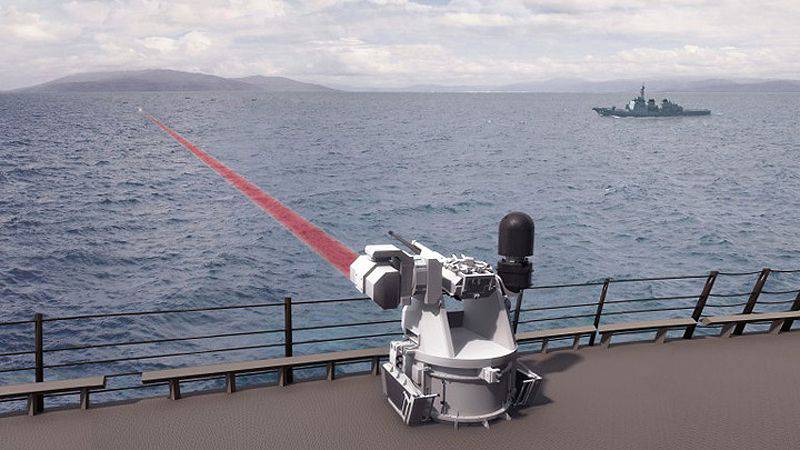
In 2011, BAE Systems received a contract worth 2,8 million dollars from the US Navy to demonstrate the Tactical Laser System (TLS) tactical laser system, which can be integrated into existing ship installations
High performance in all conditions
When directed to moving targets, the VEL will have to cope with the turbulence of airflow, dust and humidity. The movement of the platform and the distortion of the laser beam caused by weather and other external conditions, from the very beginning of the development were the most serious problems. Small-sized UAVs are difficult to detect and, therefore, difficult to intercept, especially in difficult and changing external conditions.
Boeing successfully tested its HEL MD installation at the White Sands site in 2013, in hot and dry conditions with turbulence of the finest dust, and in September, 2014 conducted another test at Eglin airbase, but in opposite conditions, surrounded by swamps and at high humidity. During the hurricane storm and lightning strikes, the HEL MD system installed on the Oshkosh military truck was able to track and hit several 60-mm mines and UAVs over a distance of 5 kilometers. The director of directional energy systems at Boeing said that “given the windy, rainy and foggy weather in Florida, these firing at the steel were the most difficult challenge to install HEL MD with a 10 kW laser.” However, for successful work in conditions of high clouds and fog, it is necessary to further increase the power of the VAL.
In the future, Boeing should install a laser with 50 or 60 kW in the HEL MD system. The own-designed 50 kW and 100 kW lasers installed on the latest versions of the HEL MD system will increase the effective range of the laser, as well as reduce the time to hit the target. Lasers are also well suited for neutralizing UAVs with optical sensors used as reconnaissance and observation platforms. A laser beam with the minimum required power, aimed at camera lenses and sensors, can blind them at long distances.
Ship installations
The prototype of laser weapons for the US Navy is seen as an extremely necessary means of dealing with growing threats at sea - unmanned and light aircraft, as well as small-sized combat boats. After many years of development, in 2009 a major technological breakthrough was made when at sea the American LaWS (Laser Weapon System) laser system fleet UAV was first captured for escort and destroyed. The Naval Research Directorate (NRU) developed this directed energy system with the Naval Systems Command, the Naval Research Laboratory, the Naval Surface Weapons Development Center in Dahlgren and Kratos Defense & Security Solutions. Two major demonstrations took place in 2011, when a laser destroyed several small boats from a destroyer, and during 2012 trials, a LaWS launcher shot down several unmanned aerial vehicles.
For tests in the Persian Gulf, which took place in the middle of 2014, an improved version of the LaWS, upgraded as part of the NRU program, was installed on the PONCE landing ship of the US Navy. These successful tests allowed the fleet to continue work on laser weapons. The system consists of six commercial fiber lasers and a single monitoring and control console, behind which an officer of surface fighting sits. In order to disable or destroy the target, the officer directs and switches on the laser using a controller similar to a controller for video games.
NRU Navy also heads the program for solid-state laser SSL-TM (Solid-State Laser-Technology Maturation). Together with Northrop Grumman, BAE Systems and Raytheon, we are developing prototypes of ready-to-fight and low-cost LaWS systems for missile destroyers and coastal warships to be manufactured in 2016. In February, 2015, the company also won an American fleet contract worth 29,5 million dollars to manufacture a prototype HP BCSS (High Power Beam Control Subsystem) beam control subsystem compatible with VAL.
In June, the US Navy 2015 expressed an intention to equip their new aircraft carriers of the GERALD R. class FORD less expensive than the existing shipboard air defense missiles (for example, ESSM [Evolved SEA SPARROW Missile] and RAM [Rolling Airframe Missile]) with laser armament 13800 total voltage volts, which is 300% more power generation for NIMITZ class ships. The current laser technology requires a large amount of electricity on board, they are cumbersome, but progress does not stand still, there are smaller systems with less power consumption.
A four-channel mirror optics with high sensitivity is used to track targets and set up a laser beam in MBDA's high-energy laser.
Less than 10 dollars per shot
The main advantage of VAL compared with traditional kinetic weapons is its cost. While the development of VEL costs millions, after the introduction of these systems into service, they have low operating costs compared to traditional ballistic and guided munitions. To knock down a UAV, installing a VEL requires diesel on 1-5 dollars, while a rocket costs 100000 dollars and more. According to the head of the directional energy systems at Boeing, “an inexpensive rocket costs one hundred thousand and that’s one launch. A one-time aiming laser gun costs less than 10 dollars. ”
Lasers can also significantly increase the defensive capabilities of surface ships through an almost unlimited store, since the number of traditional combat vehicles on these ships is limited.
Fiber forward
Fiber lasers, which for Western countries are mainly developed by IPG Photonics, currently consume kilowatts, which is significantly less than megawatt devices that were once intended for SDI. Lasers of this type are smaller, they also need less energy to maintain the characteristics of the beam. Although fuel-powered laser systems can perform their tasks and cause necessary damage, they consume a tremendous amount of energy and are too cumbersome to install on an aircraft or vehicle. Chemical lasers are efficient and do not need electrical energy, but they are almost as cumbersome as fuel-powered laser systems. For this reason, the development of the Airborne Airborne Laser (ABL) of the US Air Force did not continue, although in the 2010 year, thanks to its good optical system, it was able to destroy a ballistic missile in flight.
Optical fibers collect optical energy from advanced versions of laser diodes (their cheap counterparts are used in DVD players) and then increase the flow of light to high power, converting electrical energy into optical energy with an efficiency over 30%, which is close to the efficiency of chemical lasers and double more efficiency of solid-state lasers - small and compact, but not generating sufficient power or not having sufficient range. In addition, fiber lasers can quickly dissipate the heat generated, respectively, have a longer service life and low operating costs. Boeing's electrophysicists say that "a fiber laser can neutralize many targets in just two cups of fuel."
Europe ahead
The German company MBDA has also developed a fiber laser system with a power of 40 kW. Its first tests were successfully passed in October 2012, then the artillery shells, towed by air at a distance of about 2 km, were destroyed by a laser. Compared to conventional ammunition, precision-guided guidance also reduces the risk of indirect damage.
In June, MBDA reported that a free-living mini-UAV was successfully captured, escorted and destroyed by a laser machine a few seconds after the start at the testing ground in Bavaria. The drone, which maneuvered in the target area at a distance of approximately 500 meters, was hit by a laser setup in which the beams from several sources were combined into one powerful beam after a multi-stage tracking procedure.
At the next stage, a mobile demonstration unit-laser gun with an output power of 120 kW will be developed, which will use reflective optics, such as the Newton's reflecting telescope, where each laser module is controlled by its own focusing mirror, which directs the beam to one large main mirror. According to MBDA, the advantage here is that mirrors absorb less energy compared to lenses, and therefore, without fundamental changes, the output power of the optical system can be significantly increased.
Rheinmetall invested heavily in the design and development of VEL and at IDEX 2015 showed its laser gun mounted on the BOXER 8x8 armored personnel carrier. The company explained that during the tests conducted in Switzerland, the VEL units were integrated into three ground platforms BOXER, the M113 APC BTR and the Tatra 8x8 truck. During the demonstration, the installation of VEL on the BOXER (configured for 5 kW and 10 kW lasers identical in size and weight) neutralized a large-caliber machine gun mounted on a pickup truck. Sensors mounted on the dummy confirmed that during the whole process the levels of laser radiation were satisfactory. The air defense system, consisting of a SKYGUARD radar and a laser gun, also demonstrated its effectiveness against a completely new set of targets - small rotary-wing UAVs, also known as quadcopters. The SKYGUARD radar detected and identified the stuck quadcopter, and installing the VAL on the BOXER took it to escort and destroyed it. Rheinmetall has demonstrated that its 20-kilowatt laser machine (Mobile HEL Effector) on a Tatra truck can neutralize or destroy radio antennas, radar, power systems, and even weapons systems with minimal indirect damage. From a distance of 2000 meters, in a few seconds, optical devices such as telescopic weapons sights and remotely controlled cameras were put out of action. Using the example of its Air Defense HEL air defense system, Rheinmetall demonstrated the capabilities of VAL in air defense scenarios. In four seconds, the 30 kW demo laser setup destroyed an 82-mm mortar mine from a distance of 1000 meters. Also during this large-scale demonstration in Switzerland, several jet UAVs were successfully shot down.
VEL are preparing for combat work
Real conflicts, such as rocket attacks on Israeli territory from the Gaza Strip, are becoming a powerful incentive for further developments in the field of VAL. So Lockheed Martin created its ADAM (Area Defense Anti-Munitions) air defense system, which, like the prototype HEL MD from Boeing, uses a laser with a power of 10 kW. The company claims that the system can also destroy boats, UAVs and small-caliber missiles at distances up to 1,5 km.
Lockheed Martin also manufactured the ATHENA Advanced Test High Energy Asset, which in March 2015 demonstrated its capabilities and disabled the engine of a small truck. When using the same adaptive (self-adjusting) optics as in the ABL installation, ATHENA can be combined with another fiber laser of the same company, which has the designation ALADIN (Accelerated Laser Demonstration Initiative).
This is nothing particularly new, since Rafael and General Dyanmics Ordnance and Tactical Systems signed a license agreement for the delivery of the THOR module to the US military in October 2006 (option 7,62-mm / 12,7-mm remote-controlled combat module Mini-SAMSON), which, using an air-cooled laser mounted on it, can destroy IEDs and other explosive objects from a safe distance.
Endurance project
In November 2014, Northrop Grumman Aerospace Systems received a contract worth 20,2 million dollars from the Advanced Research and Development Office of the United States Department of Defense (DARPA) for the second phase of the Endurance project. Within its framework, a VEL will be developed by March of 2016, which will be able to protect aircraft from ground-to-air missiles with laser and infrared guidance. At the first stage of this project, the Lockheed Martin division for special systems received a contract in 2013.
Previously, the current Endurance program was part of the DARPA VAL weapons program, named EXCALIBUR. As part of EXCALIBUR, coherent optical phased arrays for VAL weapons, which would be 10 times lighter and more compact than chemical laser systems, should have been developed. Now, under the Endurance program, a miniature laser is being developed for low-maintenance air applications. The development uses a variety of breakthrough technologies for miniaturization of components, high-precision tracking of targets, target identification, beam control and control electronics. The ultimate goal is to create a VEL in a suspended container for manned and unmanned vehicles, as well as a light optical system for forming and controlling the beam for coarse and precise tracking of moving targets.
Rheinmetall has successfully tested its new 50 kW laser demonstrator, destroying two drone at a distance of 2 kilometers
Beam control systems for medium power lasers appeared at the end of the 60s of the late 70s. In the first laboratory systems, the beams were generated using heavy water-cooled copper optics and a sequence of open beams with commercial fans to supply fresh air. In subsequent years, they developed into high-precision stabilized systems with uncooled, self-adjusting optics with a high reflectance, which makes it possible to compensate for the nonideality of laser beams and atmospheric distortions.
Is the future here?
During testing by Boeing, installing HEL MD in a fully autonomous mode in May 2014 revealed one flaw. The noiselessness of the laser meant that if the target did not explode when destroyed, the laser system operator would not know if it was incapacitated. Therefore, the company has built in the process of neutralizing sound signals, suggesting the idea of science fiction films. Although real lasers are not as futuristic as in these films. The MBDA company says that after 2015, it will take another five years to create fully operational and ready-to-use systems, at least in the 10 kW class. But the opinion of the head of work on photonics from the Livermore National Laboratory "This is not the phasers from the Star Trek television series (Star Trek) ... It will take some time and you can only talk about destroying targets in any conditions. In the meantime, having a basic level, without seeing the target, in heavy rain or fog, you will not fall into it. ”
But the future is already here. The head of the New American Security Center admits that high-energy laser-based weapons “cannot be as grand and strategic as the Star Wars concept.” However, speaking of its paramount importance for the modern battlefield, he added: “It can save lives, protect American bases, ships and military personnel ... After nearly a half century of searching, the US military is now on the verge of final deployment of ready-to-use directional weapons.”
Star Wars. Episode 0. Very near future
According to the military of different countries, the future war will be a war of lasers. Lasers on new combat fighters are an attractive prospect, but there is also a lower-hanging fruit in the world of science fiction weapons that the US Air Force hopes to be the first to break. Why not install lasers on heavier and more spacious armed transport planes (ganships)?
According to the research laboratory of directed energy, in addition to installing a laser cannon on the US Air Force gunship, they want to have a laser gun in the underwing container, which can be realized already on the next-generation fighter jets.
The British Department of Defense is looking for a contractor to produce a demonstration model of a directed energy weapon system. If a new British laser is developed and implemented, it will not just dazzle, it will burn. An American laser gun mounted on the US PONCE naval vehicle destroyed a drones and mock weapon during a demonstration to the Persian Gulf in 2014. The German laser also shot down drones, and Lockheed Martin is seriously considering the prospects for aircraft with laser guns that can shoot down ground-to-air missiles. The US Navy is building a truck system that will fight UAVs with lasers, and huge amounts of money are invested in this system. As part of the GBAD (Ground-Based Air Defense Directed Energy On-The-Move) Air Defense Ground Defense Program, a laser is mounted on a light machine, and touch equipment is on a couple of other machines. Weapons directed energy, installed on the ship, already burned holes in drones. But modern warships have onboard energy sources of enormous power; It is expected, for example, that the futuristic destroyer ZUMWALT of the US fleet will have 58 megawatts reserved for such systems.
The US Navy plans to "complete destruction of stationary targets" by the end of this year, which probably means a standing truck hitting the target with its laser gun. In 2016, the Naval Navy Research Administration (NIU Navy) plans to "demonstrate a single target defeat from a standstill, but with tracking and transmission of target data during movement." On 2017, the goal is to demonstrate the ability of the system to shoot down UAVs, change positions, and then continue to shoot down UAVs. If the system works as planned by the developers, the marines will be able to disable enemy reconnaissance UAVs very quickly, blinding and disabling all their electronic systems.
The US Navy and Air Force together want to develop a laser system to combat land mines and improvised explosive devices (IEDs). It is assumed that the RADBO laser system (Recovery of Airbase Denied by Ordinance - cleaning of airbases from explosive objects) will be installed on the roof of army vehicles of the category MRAP (with enhanced mine protection). The source of energy for the laser system RADBO are two alternators, together producing current 1100 amperes. The laser system will be able to detonate explosive objects from a distance of almost 300 meters, while all those sitting in the MRAP machine will be protected from possible subsequent explosions. In case the bomb is laid under stones or in the cracks, the RADBO system has a mechanical arm that can lift up to 23 kg. The laser system with some stretch can deal with moving targets, but fixed mines and IEDs are ideal objects for it. Tests of the RADBO system were completed in September of this year.
RADBO laser system for the disposal of unexploded ordnance and deactivation of minefield fields
Materials used:
www.boeing.com
www.navy.mil
www.mbda-systems.com
www.rheinmetall.com
www.lockheedmartin.com
www.northropgrumman.com
www.baesystems.com
www.wikipedia.org
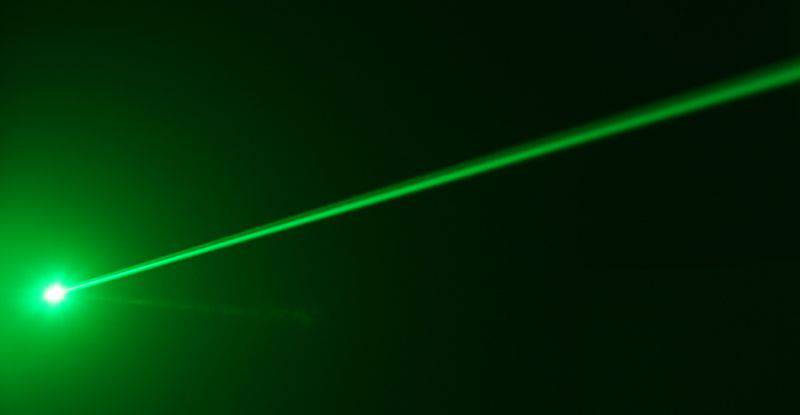
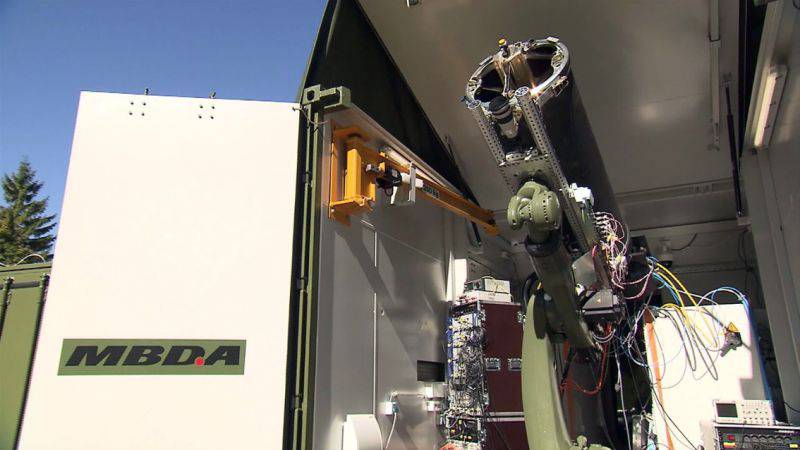
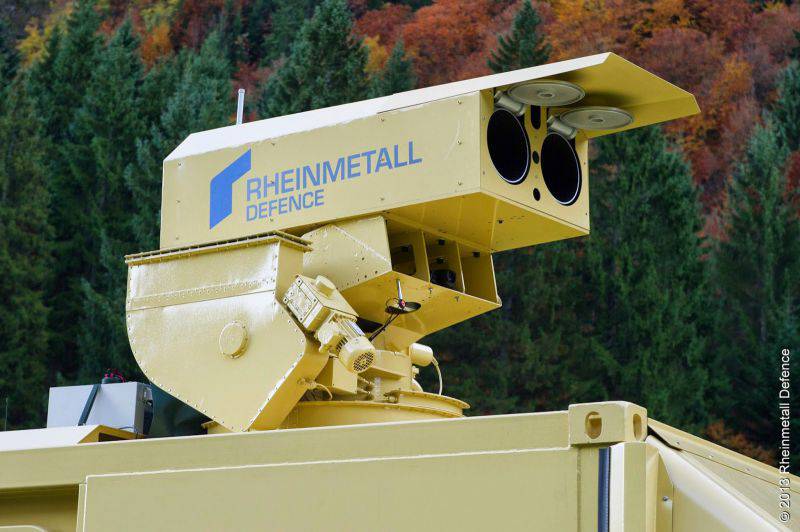
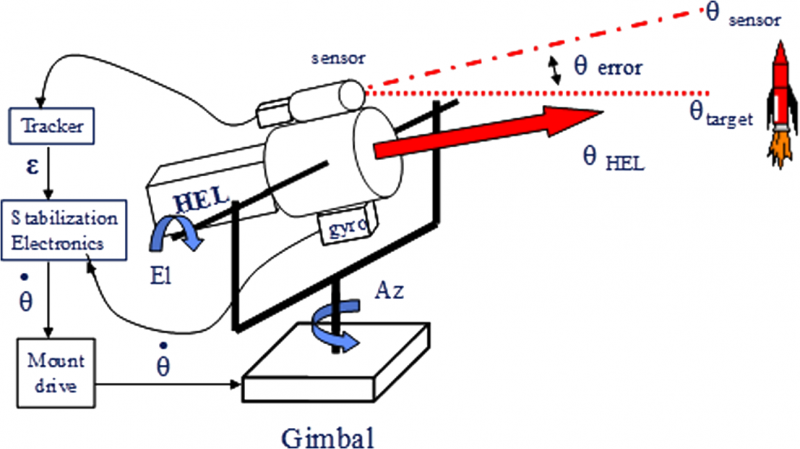
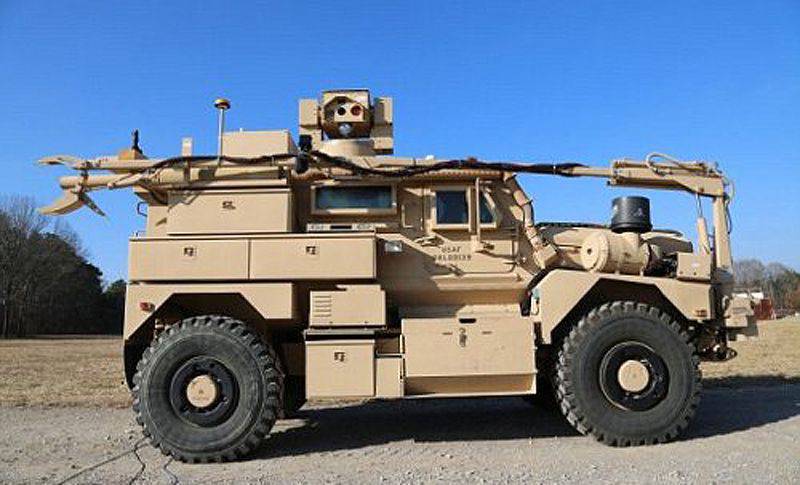

Information